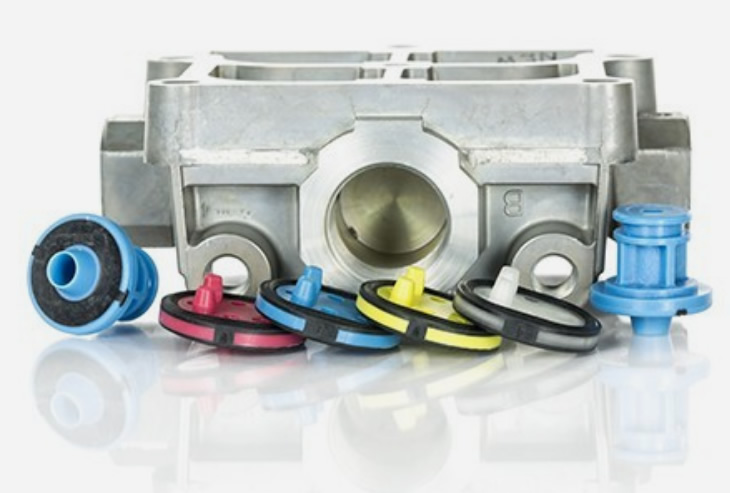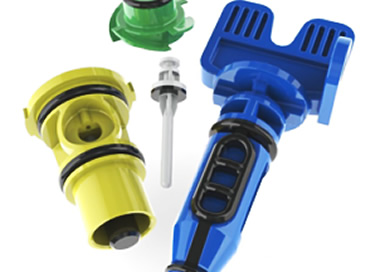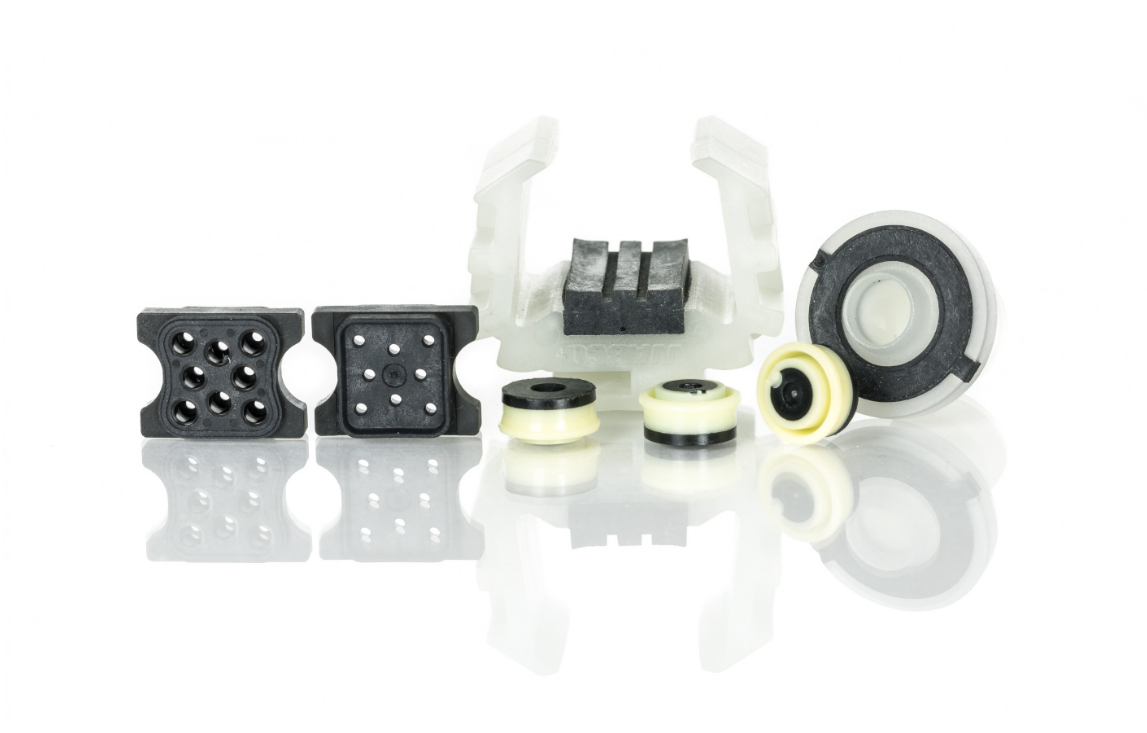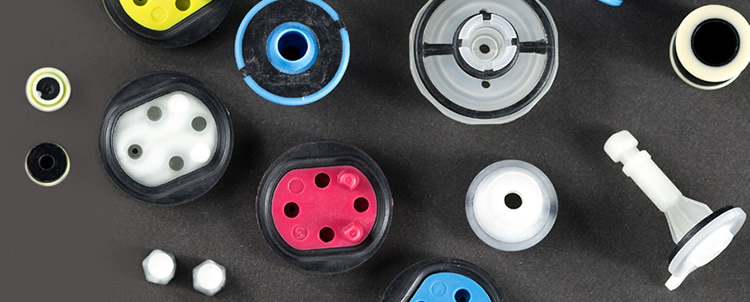2-Shot molding / 2K molding


Description
2 Shot molding(2 component molding / 2K molding / 2K injection / Overmolding) optimises the co-polymerisation of hard and soft materials to create a powerful molecular bond.
Ming-Li uses thermoplastic elastomers and plastics for the 2 Shot moulding(2 component molding / 2K molding / 2K injection / Overmolding) process as traditional thermoset compounds (such as nitriles, fluorocarbons, EPDM’s) are not suitable.

Range
- Styrene Block Copolymers (TPE-S)
- Thermoplastic Polyurethane Block Copolymers (TPE-U)
- Copolyesters (TPE-E)
- Copolyamides (TPE-A)
- Olefinic Thermoplastic rubbers (TPE-O)
Ming-Li typically uses the following plastic materials for 2 Shot moulding(2K molding / 2K injection / Overmolding) :
- Polyamide (PA/Nylon)
- Polybutylene Terephtalate (PBT)
- Polycarbonates (PC)
- Polypropylene (PP)
The 2 Shot moulding process allows us to design and manufacture complex, multiple material parts for our customers to perform a sealing function.
Additionally, the multi-shot moulding process can also be used as a cost effective method to bond materials in different colours for cosmetic purposes.

Two shot molding / 2K molding / Overmolding Design Guide
Remember that 2 Shot molding / overmolding is rarely used to cover the entire base substrate. Instead, apply 2 Shot molding / overmolding in sections. For each of these, keep in mind these useful design tips:
- Work with your manufacturing partner to ensure the compatibility between the substrate and the TPE or TPU.
- Use a TPE or TPU that has a melt temperature lower than that of the base plastic.
- Apply an overmold that is slightly thinner than the substrate which supports it.
- Design the overmold to sit just below the surface of the substrate.
- If you need more holding power, design undercuts, keyways, and other mechanical features to lock the materials together.
Key elements for two shot molding / 2K molding / Overmolding
Two-shot molding, also known as two-shot injection molding or dual-shot molding, is a specialized manufacturing process that enables the production of complex parts with different materials or colors in a single molding cycle. Key elements of two-shot molding include:
Mold Design: The design of the mold is critical for two-shot molding. It must incorporate multiple cavities or cores to accommodate the two different materials or colors being injected sequentially. Mold design considerations include gating, parting lines, cooling channels, and alignment features.
Material Selection: Two-shot molding requires selecting compatible materials that can bond together during the molding process. Typically, a rigid thermoplastic is used for the first shot (substrate), and a softer thermoplastic or elastomer is used for the second shot (overmold). Material compatibility, adhesion properties, and performance requirements must be carefully evaluated.
Injection Molding Machine: Two-shot molding requires a specialized injection molding machine capable of performing sequential injections of different materials or colors. The machine must have multiple injection units, barrels, and nozzles to facilitate the two-shot molding process.
Injection Molding Process Parameters: Optimizing injection molding process parameters is essential for achieving uniform filling of the mold cavities and proper bonding between the two materials. Parameters such as temperature, pressure, injection speed, and hold time must be carefully controlled for each shot to ensure part quality and consistency.
Material Handling and Mixing: In two-shot molding, the first shot material is injected into the mold cavity, followed by a second shot of a different material or color. Proper material handling and mixing systems are necessary to ensure accurate dosing and mixing of the materials, as well as precise injection timing and sequencing.
Tooling and Tool Maintenance: Maintaining precision tooling is crucial for achieving high-quality two-shot molded parts. The mold must be designed for easy maintenance and cleaning to minimize downtime and ensure consistent part production. Regular maintenance and inspection of the mold are essential for extending tool life and preventing defects.
Part Ejection and Handling: After the two-shot molding process is complete, the molded parts must be ejected from the mold cavities and handled carefully to avoid damage or distortion. Proper part ejection mechanisms and handling systems are necessary to ensure efficient production and maintain part quality.
Quality Control and Inspection: Implementing robust quality control measures and inspection procedures is essential for verifying part dimensions, surface finish, and material properties. Inspection methods may include visual inspection, dimensional measurement, and testing for material adhesion and strength.
By addressing these key elements effectively, manufacturers can optimize the two-shot molding process to produce high-quality parts with complex geometries, integrated features, and multi-material compositions for a wide range of applications across industries.
Know more for 2 Shot Overmolding
This type of plastic overmolding, sometimes called two-shot, multi-shot, or double-injection molding, adds additional material such as thermoplastic elastomer (TPE) to plastic substrates to improve the aesthetics, handling characteristics, grip, impact resistance, or environmental resistance of injection molded parts. The overmolding process is usually performed by way of multi-barrel injection molding machines, the process adding additional material shortly after the substrate is formed to create strong bonds between materials. Plastic overmolding serves to eliminate steps in the manufacturing process while creating enhanced injection molded products.
Depending on the materials selected for the substrate and overmold, materials may be bonded chemically or mechanically (via undercuts, for example). In many instances, mechanical bonding is recommended to fortify any chemical bonding that may take place. Among the many substrate materials that are suited to overmolding, polycarbonate, ABS, HDPE, and nylon are common. Overmold materials include thermoplastic elastomers like thermoplastic polyurethane (TPU), thermoplastic rubber (TPR), and thermoplastic vulcanite (TPV), as well as materials like styrene-ethylene/butylene-styrene copolymer (SEBS). Silicone overmolding is also used, especially when a softer rubber surface is needed for a plastic part.
This is just a partial overview of 2 Shot molding(2 component molding / 2K molding / 2K injection / Overmolding). Are they the right solutions for you? Not sure how to apply them to your next project? Just contact our technical experts and we can offer helpful advice about how to get the best results from both processes.
https://ceetak.com/seal-products/2-shot-moulding/


